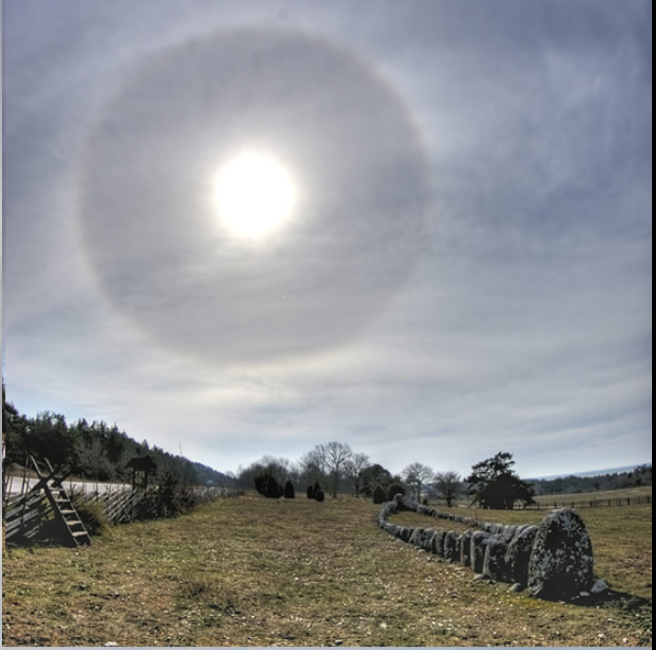Halo & Stone Ship
Halo & Stone Ship: A Fascinating Atmospheric Optics Phenomenon
Atmospheric optics never fails to amaze us with its stunning displays of natural phenomena. One such captivating sight is the halo, a luminous ring that encircles the sun or moon. In this article, we will delve into the intriguing world of halos and explore a unique occurrence where a halo gracefully embraces a stone ship monument in Fröjel, Gotland, Sweden.
The Stone Ship: A Window to the Past
The stone ship at Fröjel is an ancient funeral monument that dates back two and a half thousand years to the late Bronze Age. This remarkable structure offers us a glimpse into the rich history of the region and serves as a testament to the ingenuity and craftsmanship of our ancestors.
The Enigmatic 22° Halo
Now, let's shift our focus to the captivating halo that adorns the sky above the stone ship. Unlike a complete ring, the 22° halo is formed by poorly oriented ice crystals of an uncertain kind. These ice crystals refract sunlight, creating a luminous circle that starts approximately 22° away from the sun and extends outward to about 50°.
The Dark 'Hole in the Sky'
Within the 22° halo lies a mysterious phenomenon known as Alexander's Dark Band. This dark band appears as a shadowy region devoid of glinting ice crystals. The inner limit of the 22° halo, at 22° from the sun, represents the minimum angle at which light is deviated when passing through an ice crystal with inclined entrance and exit faces at 60°. Sunlight cannot be deflected through a smaller angle, resulting in a distinct dark area in the sky.
Exploring the Halo's Features
The HDR tonemapped image captured by Måns Hagberg beautifully showcases the intricate details of the halo above the stone ship. By employing tone mapping techniques, the image reveals the darker sky within the halo, allowing us to appreciate its ethereal beauty.
The Halo's Origins: Ice Crystals and Light Refraction
To understand the formation of halos, we must delve into the science of ice crystals and light refraction. Halos occur when sunlight passes through ice crystals suspended in the atmosphere. As light enters and exits these crystals, it undergoes refraction, causing it to bend and create the mesmerizing halo phenomenon.
The Intricacies of Halo Formation
The specific orientation and shape of ice crystals play a crucial role in determining the characteristics of a halo. Various factors, such as crystal size, symmetry, and orientation, contribute to the unique display of colors and arcs within a halo. The intricate interplay between these factors gives rise to the mesmerizing patterns we observe in the sky.
Unraveling the Mysteries of Atmospheric Optics
Atmospheric optics continues to be a field of study that fascinates scientists and enthusiasts alike. Through careful observation and scientific analysis, we gain a deeper understanding of the intricate mechanisms that shape our visual experiences. The study of halos and other atmospheric phenomena allows us to explore the wonders of nature and marvel at the beauty that surrounds us.
Capturing Nature's Masterpieces
Photographers like Måns Hagberg play a vital role in capturing these fleeting moments of atmospheric magic. Through their lens, they immortalize these natural phenomena, allowing us to appreciate their grandeur even if we cannot witness them firsthand. The HDR tonemapped image of the halo above the stone ship serves as a stunning testament to the power of photography in preserving and sharing these awe-inspiring sights.
A Window to the Past, an Ode to Nature
In conclusion, the halo gracefully adorning the stone ship monument in Fröjel, Sweden, serves as a mesmerizing intersection of history and nature. As we gaze upon this ethereal display, we are reminded of the enduring power of the past and the ever-changing beauty of our natural world. Let us continue to explore, appreciate, and protect these remarkable phenomena that connect us to our rich heritage and the wonders of the universe.

A 22° Halo looms over a stone ship an HDR tonemapped image by M�ns Hagberg. ©Måns Hagberg, shown with permission.
The ship is a two and a half thousand year old late Bronze Age funeral monument at Fröjel, Gotland, Sweden.
The tone mapping reveals well the darker sky inside the 22 degree halo.
The halo formed by poorly oriented ice crystals of an uncertain kind is not a 'ring'. The halo light starts, and is most intense, some 22° from the sun and extends outwards to 50°.
The inner limit of 22° is the minimum angle that light is deviated when passing through an ice crystal with entrance and exit faces inclined at 60°. Sunlight cannot be deflected through a smaller angle and consequently there is a dark 'hole in the sky' where no ice crystals glint.
Alexander's Dark Band between rainbows is similarly produced.

Note: this article has been automatically converted from the old site and may not appear as intended. You can find the original article here.
Reference Atmospheric Optics
If you use any of the definitions, information, or data presented on Atmospheric Optics, please copy the link or reference below to properly credit us as the reference source. Thank you!
-
<a href="https://atoptics.co.uk/blog/halo-stone-ship/">Halo & Stone Ship</a>
-
"Halo & Stone Ship". Atmospheric Optics. Accessed on November 26, 2024. https://atoptics.co.uk/blog/halo-stone-ship/.
-
"Halo & Stone Ship". Atmospheric Optics, https://atoptics.co.uk/blog/halo-stone-ship/. Accessed 26 November, 2024
-
Halo & Stone Ship. Atmospheric Optics. Retrieved from https://atoptics.co.uk/blog/halo-stone-ship/.